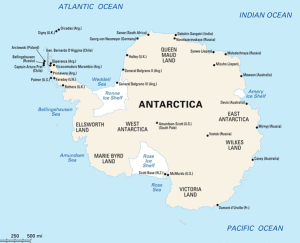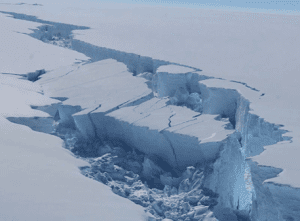TAG: GS 1: GEOGRAPHY
THE CONTEXT: Scientists have identified a new tipping point that could trigger “runaway melting” of Antarctic ice sheets.
EXPLANATION:
- This critical threshold is reached when warm ocean water intrudes between the ice and the land it rests upon, accelerating the melting process.
- This phenomenon was highlighted in a study published in the journal Nature Geoscience recently.
Limitations of Current Climate Models
- Although this type of melting has been studied before, the models used by the UN’s Intergovernmental Panel on Climate Change (IPCC) have not yet incorporated this particular process into their projections.
- The study’s findings suggest that previous estimates of ice loss due to global warming have been systematically underestimated.
- As global temperatures continue to rise due to human activities, the melting of Antarctic ice sheets poses a significant threat to global sea levels, with serious implications for coastal communities worldwide.
 Antarctica
Antarctica
Mechanism of Runaway Melting
- The study explains that increases in ocean temperature can lead to a tipping point, beyond which ocean water begins to intrude beneath the ice sheet in an unbounded manner, initiating a process of runaway melting.
- Antarctic ice sheets are grounded on bedrock but extend beyond the coastline to float on the ocean.
- When warm seawater seeps into the “grounding zone”—the area where land and ice meet—it further penetrates inland, melting the ice from below.
- As per the study, the Pine Island glacier, currently Antarctica’s largest contributor to sea-level rise, is at high risk of melting due to the slope of the land that allows in more sea water.

Studies have shown that warm seawater is seeping into the ‘grounding zone’, where land and ice meet
Accelerating Intrusion of Warm Seawater
- As seawater warms, even by a small fraction, the rate of intrusion into the grounding zone increases.
- Initially, the intrusion distances are short, around 100 meters, but with continued warming, it can extend to tens of kilometers.
- This process significantly accelerates ice melt by heating it from beneath.
- “Every 10th of a degree (of warming) makes these kinds of processes closer, these tipping points closer.”
Implications for Sea Level Rise
- The potential for runaway melting of Antarctic ice sheets has profound implications for global sea levels.
- As the ice melts, it contributes to the rising sea levels, which threaten coastal areas with increased flooding, erosion, and other related impacts.
- The study underscores the urgency of addressing climate change to mitigate these risks.
IPCC:
- The IPCC is the United Nations body for assessing the science related to climate change.
- It was established by the World Meteorological Organization (WMO) and the United Nations Environment Programme (UNEP) in 1988.
- IPCC Secretariat is located in Geneva, Switzerland.
- It has 195 Member countries.
- Its objective is to assess scientific, technical, and socio-economic information relevant to the understanding of human-induced climate change, potential impacts of climate change, and options for mitigation and adaptation.
- The main activity of the IPCC is the preparation of reports assessing the state of knowledge of climate change. These include assessment reports, special reports and methodology reports.

